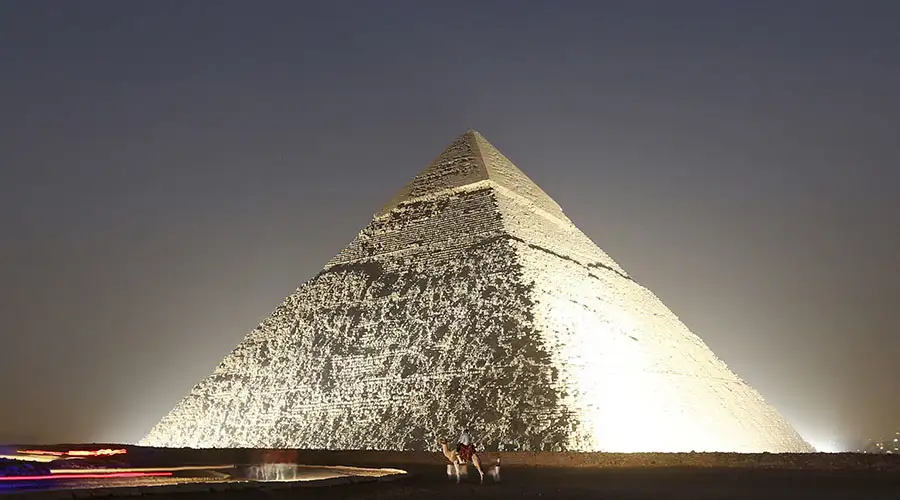Giza Necropolis: The Land of the Pyramids
The Giza Necropolis is an area near Giza, Egypt, that is home to some of the most iconic monuments in the world – the Pyramids of Giza. For centuries, these grand structures have been a source of intrigue and wonder for people all over the globe. In this blog post, we will explore the history and mystery surrounding the Giza Necropolis, uncovering the secrets of the Pyramids of Giza.

Location and Layout
The Giza Necropolis is located in Giza, Egypt, just outside of modern-day Cairo. It includes three large pyramids known as the Pyramids of Giza, which were built during the Fourth Dynasty of ancient Egypt. The most famous and largest of the three is the Great Pyramid of Khufu, which is the oldest and only surviving ancient wonder of the world. Other structures in the necropolis include the Great Sphinx of Giza, numerous cemeteries and tombs, and several smaller pyramids. The entire complex covers an area of over 13 square kilometers and is surrounded by a wall that was constructed in the late Old Kingdom period. The Pyramids of Giza are the most iconic part of the Giza Necropolis and are made up of three separate pyramids: Khufu’s Pyramid (also known as the Great Pyramid), Khafre’s Pyramid (the second largest), and Menkaure’s Pyramid (the smallest).

History
The Giza Necropolis has a long and rich history. The most famous structures in the area are the three Great Pyramids of Giza, which have been recognized as one of the Seven Wonders of the Ancient World. They were constructed around 2550 BC by Khufu, Khafre, and Menkaure, the sons of the fourth-dynasty pharaoh Sneferu.
The Great Pyramids of Giza are the only surviving monument of the original Seven Wonders of the Ancient World. In addition to these impressive structures, the area also contains several other smaller pyramids, tombs, temples, and a funerary complex known as the Great Sphinx.
The location and layout of the Pyramids of Giza indicate that their construction was well planned out by the ancient Egyptians. The three main pyramids were built on a north-south axis and aligned with the cardinal points. This alignment helped to emphasize the importance of the site and its role in providing an afterlife for Pharaohs and their families.
The Pyramids of Giza also served an important religious purpose. It was believed that the deceased pharaohs would ascend to the heavens and become gods in their own right. As such, they were venerated and worshipped by their people, making them an integral part of the religious landscape of Ancient Egypt.

The Great Pyramid of Khufu
The Great Pyramid of Khufu, also known as the Pyramid of Cheops, is the oldest and largest of the Pyramids of Giza. Located on the Giza Plateau in Cairo, Egypt, it is the only surviving member of the Seven Wonders of the Ancient World. Built around 2580 BC, it stands at an impressive 481 feet tall and was originally covered with smooth, white casing stones that reflected the sun, making it shine like a jewel.
The Great Pyramid of Khufu was built as a tomb for the Pharaoh Khufu and contains three smaller pyramids inside which were used to house the Pharaoh’s family members. Inside the pyramid there are two chambers, the King’s Chamber and the Queen’s Chamber, which are connected by a series of passages. In addition to the chambers, there are many other smaller structures within the pyramid complex including underground tunnels, storage rooms, and an exterior entrance.
Archaeologists believe that the Great Pyramid of Khufu took over 20 years to build and involved hundreds of thousands of laborers. It is considered a masterpiece of engineering and is thought to have been built using ancient Egyptian mathematics and surveying techniques. Even today, scientists and engineers marvel at its construction and have yet to replicate its incredible design and accuracy.

Other Structures in the Giza Necropolis
In addition to the Great Pyramid of Khufu, the Giza Necropolis is home to a complex of smaller pyramids and other structures. The two most famous of these are the Pyramids of Giza, which stand on either side of the Great Pyramid. These are the Pyramid of Khafre and the Pyramid of Menkaure, both built for two of Khufu’s successors. There are also a number of tombs that were built for nobles, officials and priests.
The Sphinx is also located in the Giza Necropolis. This limestone statue is thought to be a representation of the Pharaoh Khafre and was carved from a single piece of rock in the fourth dynasty. There are also a number of temples that were dedicated to different gods and goddesses, such as the Temple of Isis at Giza, which was an important site of worship in ancient Egypt.
The Giza Necropolis is an incredible site that contains some of the oldest and most impressive monuments in all of Egypt. It is an important part of world history and it will continue to be a source of fascination for people for many years to come.

Importance of the Giza Necropolis
The Pyramids of Giza have been an iconic landmark for centuries, and the Giza Necropolis itself has an important place in world history. The site is a testimony to the ancient Egyptians’ achievements in architecture and engineering. The Great Pyramid of Khufu, the oldest and largest of the three pyramids, was the tallest man-made structure in the world until Lincoln Cathedral was built in 1311 AD. It still stands today, more than 4,500 years after its construction, a testament to the skill and craftsmanship of its builders.
The Pyramids of Giza are also a significant part of our understanding of ancient Egypt. They provide a tangible connection to the culture and civilization that flourished in the Nile Valley from around 3200 BC to 1000 BC. Their construction involved sophisticated mathematical calculations and precise engineering techniques, which hint at a level of knowledge that was far ahead of its time.
The Pyramids of Giza are also important because they helped define the idea of a pyramid as a powerful symbol. From ancient Egypt to modern times, pyramids have served as a representation of strength and stability in many different cultures. They have become an iconic symbol of power, wealth and grandeur, and have been featured in films, literature, music and art.
Finally, the Giza Necropolis has a spiritual significance as well. Ancient Egyptians believed that their kings were gods who could ascend to the stars after death. The Pyramids of Giza were their final resting place, and they were believed to be the gateway to the afterlife. As such, the site holds immense spiritual power even today.
In short, the Giza Necropolis is an important part of our shared cultural heritage, providing a tangible connection to one of the greatest civilizations in history. Its pyramids are symbols of strength, power and achievement, while also retaining a spiritual significance that has endured for millennia.




